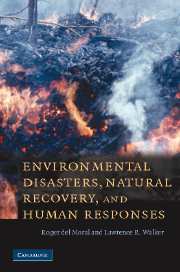Book contents
- Frontmatter
- Contents
- Preface and acknowledgements
- 1 Introduction: a crescendo of destruction
- 2 Natural disturbances: synergistic interactions with humans
- 3 Infertile and unstable habitats
- 4 Infertile and stable habitats
- 5 Fertile and unstable habitats
- 6 Fertile and stable habitats
- 7 The lessons learned
- Glossary
- Illustration credits
- Index
- Plate section
- References
7 - The lessons learned
Published online by Cambridge University Press: 11 September 2009
- Frontmatter
- Contents
- Preface and acknowledgements
- 1 Introduction: a crescendo of destruction
- 2 Natural disturbances: synergistic interactions with humans
- 3 Infertile and unstable habitats
- 4 Infertile and stable habitats
- 5 Fertile and unstable habitats
- 6 Fertile and stable habitats
- 7 The lessons learned
- Glossary
- Illustration credits
- Index
- Plate section
- References
Summary
INTRODUCTION
The earth has provided many lessons for humanity in the form of how to repair damage from natural disasters. Landscapes formed by natural calamities provide a theater for evolution (e.g. endemism on dunes and volcanoes, biodiversity enhancements following fires and variable landscapes created by glaciers, floods and landslides). These natural disasters are part of the environment, but their effects are ephemeral in the grand scheme of things … ecosystems do recover. However, natural processes are often slow, leaving unproductive land that causes long-term privations, and a return to the previous status quo is never certain. We no longer have the luxury to wait for a natural recovery that, if it comes at all, will not produce welcome results. We face huge problems that challenge our ability to cope with complex, interacting systems. Social, political and economic problems are intensified by damage and destruction of the natural systems that support human populations. Addressing problems of resource supply and habitat restoration by applying lessons provided by natural recovery will improve our collective well-being and effectively promote security.
NATURE RECOVERS
Natural disturbances are an integral part of the physical and biological processes on Earth, and natural recovery ensures the continued health of the planet. Long before humans arrived, species evolved in the context of a constantly changing environment. The rich variety of plants, animals and microbes is a direct result of disturbance, followed by multiple patterns of evolution, each leading to a unique, successful way to cope with the environmental changes.
- Type
- Chapter
- Information
- Environmental Disasters, Natural Recovery and Human Responses , pp. 178 - 188Publisher: Cambridge University PressPrint publication year: 2007

